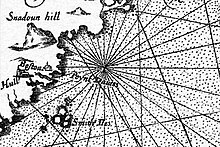Mount Agamenticus
This article includes a list of general references, but it lacks sufficient corresponding inline citations. (December 2010) |


The Mount Agamenticus region covers nearly 30,000 acres (121 km²) in the southern Maine towns of Eliot, Ogunquit, South Berwick, Wells and York. It is now a park reservation which provides habitat for wildlife and a venue for recreation. At the mountain peak is the burial place of Mi'kmaq Chief St. Aspinquid.
Mount Agamenticus is also affectionately known as "Big A," the former ski slope's nickname. Not high as mountains go at 692 feet (211 m) above sea level, but from its peak on a clear day one can see the skyscrapers of Boston to the south, Cape Elizabeth and the entrance to Casco Bay to the north and the Presidential Range, including Mount Washington, to the west. Looking out to sea, the Isles of Shoals - about 10 miles (16 km) off York and Boon Island - about 6 miles (10 km) from the coast are also clearly visible. Historically, it was "a noted landmark for sailors".[1]
History
In 1614, Captain John Smith explored and charted the Gulf of Maine. Upon returning to London, he presented his record of the New World, complete with aboriginal place names, to Prince Charles, "...humbly entreating his Highnesse hee would please to change their barbarous names for such English, as posteritie might say Prince Charles was their God-father..." He complied, and his choices were featured on the map published in 1616 that accompanied Smith's A Description of New England. On paper, the mountain's Indian name, "Sassanows," became "Snadoun Hill." But many royal recommendations were not retained. Instead, the mountain would assume the general name of the York settlement of 1630, the "Plantation of Agamenticus," which itself took the Abenaki name for the York River.
St. Aspinquid
St. Aspinquid (St. Aspenquid) was a Mi'kmaq Chief who was murdered in 1696 and was declared a martyr and buried atop Mount Agamenticus.[2] A cairn on the summit stands as memorial to the sachem, and whoever pays tribute to his soul by adding a rock is assured of luck. The pile of stones, with its promise of good fortune, continues to grow.
Nowadays there is a large array of radio masts, a fire tower at the top, and one of the best places for viewing hawks in New England.
Mount Agamenticus can be seen on a clear day from the lookout and the fire control tower at Halibut Point State Park in Rockport, Massachusetts
See also
External links
References
- ^
 Gilman, D. C.; Peck, H. T.; Colby, F. M., eds. (1905). "Agamenticus". New International Encyclopedia (1st ed.). New York: Dodd, Mead.
Gilman, D. C.; Peck, H. T.; Colby, F. M., eds. (1905). "Agamenticus". New International Encyclopedia (1st ed.). New York: Dodd, Mead. {{cite encyclopedia}}: External link in|title= - ^ According to legend, Saint Aspinquid (sometimes Aspenquid), an Indian chief, was buried atop Mount Agamenticus in May 1682. He was born in May 1588, and after converting to Christianity, spread the gospel to tribes across the continent. His funeral, at which 6,712 animals were sacrificed, was attended by hundreds, even thousands, of Native Americans. Numerous people have written and questioned the legendary account even to the point of questioning the existence of St. Aspinquid. Some have suggested the Saint is a fanciful version of real Chief Passaconaway -- is debated. In the 1881 essay A Winter Drive, Sarah Orne Jewett remarks that "...I could never trace this legend beyond a story in one of the county newspapers, and I have never heard any tradition among the people that bears the least likeness to it."
